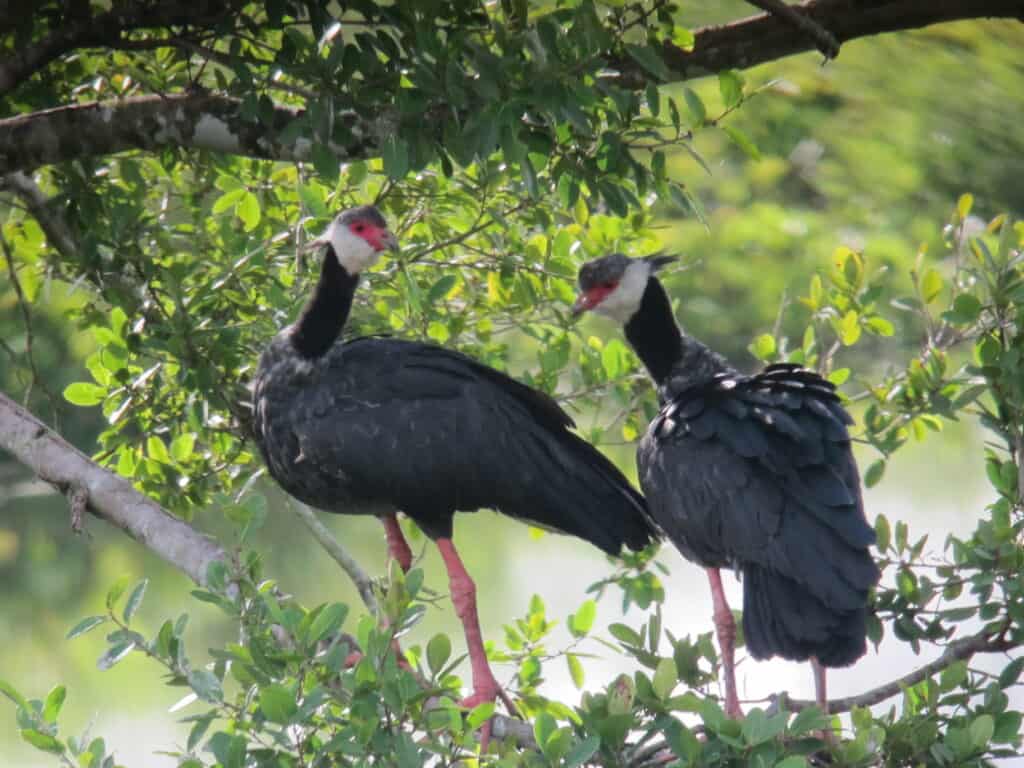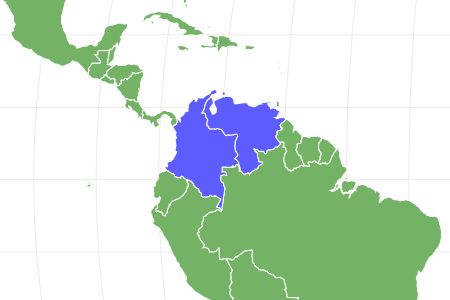They are closely related to magpie geese
Advertisement
Northern Screamer Scientific Classification
- Kingdom
- Animalia
- Phylum
- Chordata
- Class
- Aves
- Order
- Anseriformes
- Family
- Anhimidae
- Genus
- Chauna
- Scientific Name
- Chauna Chavaria
Read our Complete Guide to Classification of Animals.
Northern Screamer Conservation Status
Northern Screamer Facts
- Prey
- This species eats aquatic vegetation like roots, stems, grasses, and seeds.
- Main Prey
- Plant matter
- Name Of Young
- Hatchlings or chicks
- Group Behavior
- Group
- Pair
- Fun Fact
- They are closely related to magpie geese
- Estimated Population Size
- 1,500 to 7,000
- Biggest Threat
- Habitat loss and overhunting
- Most Distinctive Feature
- Red eyering
- Distinctive Feature
- Head tufts and hooked bills
- Incubation Period
- 42 to 44 days
- Age Of Independence
- 12 to 14 weeks
- Age Of Fledgling
- Immediately after hatching
- Habitat
- Wetlands in lowland tropical forests
- Diet for this Fish
- Herbivore
- Lifestyle
- Diurnal
- Type
- Bird
- Common Name
- Northern screamer
- Special Features
- Partially webbed feet and sharp wing spurs
- Number Of Species
- 2
- Location
- Colombia and Venezuela
- Nesting Location
- Floating vegetation in shallow water or on the ground near the water's edge
Northern Screamer Physical Characteristics
- Color
- Grey
- Red
- Black
- White
- Skin Type
- Feathers
- Lifespan
- 15 to 35 years
- Length
- 30 to 36 inches
- Age of Sexual Maturity
- More than two years
View all of the Northern Screamer images!
The northern screamer is attracted to seasonally flooded plains.
The northern screamer, also known as the black-necked screamer, is a water bird endemic to small South American regions. Its limited range puts it at risk for habitat loss and pollution, and spotting one of these birds is a rare treat. They are sturdy birds with distinctive coloring who form pair bonds and possibly mate for life. Find out everything there is to know about this uncommon screamer, including where you can find them and how to identify them.
5 Amazing Northern Screamer Facts
- The northern screamer inhabits the wetlands of Colombia and Venezuela.
- They are closely related to magpie geese.
- They are relatively sedentary, and you often find them perched on the tops of trees.
- These birds are very vocal, but their calls are loud and unharmonious.
- Northern screamers are “near threatened” due to their continuing habitat loss.
Where to Find the Northern Screamer
The northern screamer has a relatively small range, only inhabiting Northern Colombia and Northwestern Venezuela. You can find them in wetlands in lowland tropical forests, such as marshes, lagoons, swamps, well-vegetated lakes, and river banks. These birds are also attracted to flooded plains during the rainy season. To find them, listen for their loud, unharmonious calls and look to the tops of trees or near the water where they graze.
Northern Screamer Nest
Both parents assist in building their nest, which is typically floating vegetation anchored among marsh vegetation in shallow water. They may also place it on the dry ground next to the water. Their pair constructs it by finding debris and vegetation around the nesting site, such as sticks, reeds, and weeds. When completed, the nest resembles a loosely constructed circular shape.
Scientific Name
The northern screamer (Chauna Chavarria) is in the Anseriformes order, which encompasses 180 species of waterfowl. And its family, Anhimidae, represents the screamers, three South American bird species. The Chauna genus comprises the northern and southern screamers in South America’s wetlands.
Size, Appearance, and Behavior
The northern screamer is a large, solid bird closely related to magpie geese. This stout bird grows between 30 and 36 inches, but we don’t know its weight or wingspan. Their bodies are grayish-black with white streaks, and their crown and neck are black with a broad white stripe across their chin. Its legs and feet are reddish-pink, and it has a distinctive red eye ring. They have small, hooked bills, strong legs, and partially webbed feet. They also have two sharp wing spurs, which they use to deter predators (although their predators are unknown). Females are smaller than males but feature similar plumage. While they don’t technically scream, northern screamers make low, throaty sounds that resemble barking.
These birds are diurnal and like to spend their days perching on tree tops and loudly proclaiming their territory. This species forms pair bonds and may mate for life. Mates make pair calls to establish their bond and will perform other courtship displays like walking side by side, making low, course sounds, and preening. Pairs stay together during the breeding season, but after, they may form small groups. This species is mainly terrestrial but are good fliers and can quickly get to the tree tops.

Northern screamers are grayish-black with white streaks. They have broad black and white bands on their necks and heads and a red beak and eye ring.
©CC BY-SA 2.0. – License
Diet
The northern screamer eats a vegetarian diet, feeding almost exclusively on plant matter.
What Does the Northern Screamer Eat?
This species eats aquatic vegetation like roots, stems, grasses, and seeds. They will occasionally eat insects, but they are not a regular part of their diet. The northern screamer looks for food by grazing or digging with its bill.
Predators, Threats, and Conservation Status
According to the IUCN, the northern screamer is a “near threatened” species. In fact, it almost meets the criterion for “threatened” status. It has a relatively small population that continues to decline at a steady pace. They have experienced a loss of habitat due to wetland draining, pipeline and road construction, urbanization, and mangrove cutting. This species is also vulnerable to hunting, egg collecting, domestic and industrial pollution, and sewage.
Reproduction, Young, and Molting
The northern screamer can breed in its environment year-round, but the peak breeding season occurs in October and November. Breeding pairs are solitary and build their nest together. Females lay three to five yellowish-white eggs, and both parents take turns incubating for 42 to 44 days. Their young are born in an advanced state and leave the nest immediately after hatching, where they follow after their parents. They stay predominately in the water until they can fly and fledge within eight to ten weeks after hatching. This species is fully independent at 12 to 14 weeks. These birds have long lifespans and can live between 15 and 35 years.
Population
The IUCN estimates the northern screamer population to be between 1,500 and 7,000 mature individuals. This species doesn’t experience any extreme fluctuations or fragmentations in its numbers, but its population is decreasing. They are going through a slow and steady decline due to habitat loss, egg collecting, and hunting.
Similar Animals:
View all 65 animals that start with NNorthern Screamer FAQs (Frequently Asked Questions)
Why are screamer birds called screamers?
While they don’t technically scream, northern screamers make low, throaty sounds that resemble barking.
Where do screamers live?
The northern screamer has a relatively small range, only inhabiting Northern Colombia and Northwestern Venezuela. You can find them in wetlands in lowland tropical forests, such as marshes, lagoons, swamps, well-vegetated lakes, and river banks.
Where do northern screamers nest?
They make nests from floating vegetation anchored among marsh vegetation in shallow water.
How big is a northern screamer?
The northern screamer is a large, solid bird closely related to magpie geese. This stout bird grows between 30 and 36 inches, but we don’t know its weight or wingspan.
What do northern screamers eat?
This species eats aquatic vegetation like roots, stems, grasses, and seeds. They will occasionally eat insects, but it is not a regular part of their diet.
Is the northern screamer endangered?
According to the IUCN, the northern screamer is a “near threatened” species. In fact, it almost meets the criterion for “threatened” status. They are losing their habitat and are vulnerable to hunting, egg collecting, domestic and industrial pollution, and sewage.
How many eggs does the northern screamer lay?
Females lay three to five yellowish-white eggs, and both parents take turns incubating for 42 to 44 days.
Thank you for reading! Have some feedback for us? Contact the AZ Animals editorial team.
Sources
- IUCN Red List, Available here: https://www.iucnredlist.org/species/22679726/92826428
- Oiseaux-Birds (1970) https://www.oiseaux-birds.com/card-northern-screamer.html

















